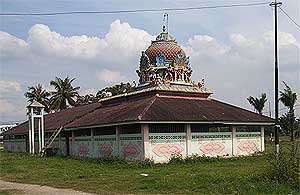I refer to Richard Teo's comments that the demolishing of Hindu temples is long overdue because the Indian community builds shrines on an ad-hoc manner and flout local regulations. Such claims not only lack understanding of the issues but are also doing a disservice to poor, voiceless Indian Malaysians.
Firstly, places of worship are juridical entities. It is absurd to classify them as illegal structures , especially those that have been in use for over 50 to 150 years. These places have been used for the spiritual development of communities in the vicinity long before the local councils were formed. Religious rights are enshrined in the constitution.
Thus, it is the duty of the government to promote, fulfill and protect these rights. If the temples have not met certain building requirements, the government is obliged to regularise them. They are certainly not vice dens to be bulldozed with such impunity.
Secondly, commercial development came around the temples in later years. Whenever such developments take place, why is that more often than not the roads run right through the temples? That is the most asked question among Indian Malaysians.
Thirdly, Hindu Malaysians do not simply build shrines wherever they please. The problem is they have become victims of development.
 Take the case of this Hindu temple (
left
) in Batu Kawan Estate. The Indians settled in Batu Kawan from the 1830s. The temple was built in 1850 and renovated in 1917 after more people had settled in the plantation and contributed to the building fund. This plantation was compulsorily acquired by the Penang government in 1992 to develop a new satellite township.
Take the case of this Hindu temple (
left
) in Batu Kawan Estate. The Indians settled in Batu Kawan from the 1830s. The temple was built in 1850 and renovated in 1917 after more people had settled in the plantation and contributed to the building fund. This plantation was compulsorily acquired by the Penang government in 1992 to develop a new satellite township.
 Since then the community leaders have been meeting the state government representatives for a systematic relocation of the temple, but they have yet to get a firm commitment from the officials. Surely, one cannot expect this community to just give up the temple, especially since they continue to live in its vicinity after buying houses in the new township (
right
).
Since then the community leaders have been meeting the state government representatives for a systematic relocation of the temple, but they have yet to get a firm commitment from the officials. Surely, one cannot expect this community to just give up the temple, especially since they continue to live in its vicinity after buying houses in the new township (
right
).
It is the same situation in Selangor, where plantations have made way for residential, commercial and recreational development. Though the Selangor government's policy stipulates that plantation companies must set aside land for such temples before the estates are turned into townships, it is hardly implemented. The companies take the easy way out by paying the plantation communities between RM10,000 and RM20,000 to remove the idols after performing the necessary religious rites.
Coupled with the fact that it is next to impossible to get approval from local councils to build non-Muslim places of worship in new townships, where would the evicted poor plantation folk take their sacred religious icons to? Is there any wonder why such small Hindu shrines spring up everywhere?

